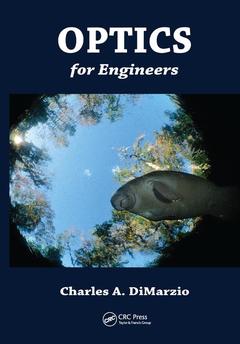Optics for Engineers
Auteur : DiMarzio Charles A.

The field of optics has become central to major developments in medical imaging, remote sensing, communication, micro- and nanofabrication, and consumer technology, among other areas. Applications of optics are now found in products such as laser printers, bar-code scanners, and even mobile phones. There is a growing need for engineers to understand the principles of optics in order to develop new instruments and improve existing optical instrumentation. Based on a graduate course taught at Northeastern University, Optics for Engineers provides a rigorous, practical introduction to the field of optics. Drawing on his experience in industry, the author presents the fundamentals of optics related to the problems encountered by engineers and researchers in designing and analyzing optical systems.
Beginning with a history of optics, the book introduces Maxwell?s equations, the wave equation, and the eikonal equation, which form the mathematical basis of the field of optics. It then leads readers through a discussion of geometric optics that is essential to most optics projects. The book also lays out the fundamentals of physical optics polarization, interference, and diffraction in sufficient depth to enable readers to solve many realistic problems. It continues the discussion of diffraction with some closed-form expressions for the important case of Gaussian beams. A chapter on coherence guides readers in understanding the applicability of the results in previous chapters and sets the stage for an exploration of Fourier optics. Addressing the importance of the measurement and quantification of light in determining the performance limits of optical systems, the book then covers radiometry, photometry, and optical detection. It also introduces nonlinear optics.
This comprehensive reference includes downloadable MATLAB code as well as numerous problems, examples, and illustrations. An introductory text for
Date de parution : 06-2017
17.8x25.4 cm
Disponible chez l'éditeur (délai d'approvisionnement : 14 jours).
Prix indicatif 220,72 €
Ajouter au panierDate de parution : 08-2011
Ouvrage de 360 p.
17.8x25.4 cm
Disponible chez l'éditeur (délai d'approvisionnement : 15 jours).
Prix indicatif 117,69 €
Ajouter au panierThèmes d’Optics for Engineers :
Mots-clés :
Spectral Radiant Exitance; Radiant Exitance; geometric optics; Stokes Vectors; apertures; Cos Θi; pupils; Point Spread Function; stops; Numerical Aperture; polarized light; Back Focal Plane; interference; Aperture Stop; diffraction; Gaussian Beam; gaussian beams; Field Stop; optical detection; Laser Radar; coherence; Front Focal Point; radiometry; Thin Lens; photometry; Solid Angle; irradiance; Focal Length; radiance; Small Angle Approximation; luminance; Front Focal Plane; Jones matrices; Exit Pupil; Mueller matrices; Entrance Pupil; Stokes parameters; Hermite Gaussian Modes; Fourier optics; Fabry Perot Interferometer; Fresnel Kirchoff integral; Playback; Fraunhofer Diffraction; Principal Planes; Exit Window



